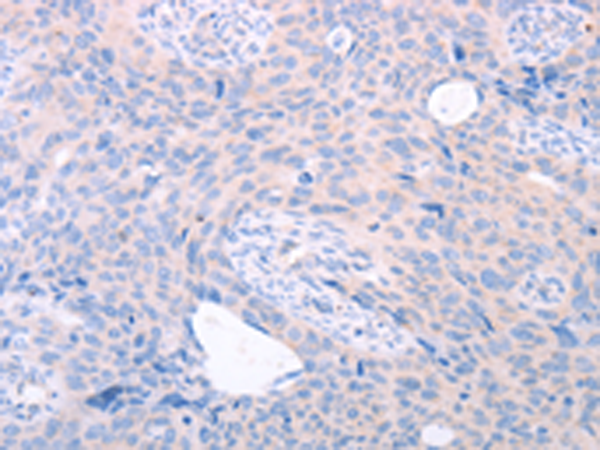


| WB | 咨询技术 | Human,Mouse,Rat |
| IF | 咨询技术 | Human,Mouse,Rat |
| IHC | 1/15-1/50 | Human,Mouse,Rat |
| ICC | 技术咨询 | Human,Mouse,Rat |
| FCM | 咨询技术 | Human,Mouse,Rat |
| Elisa | 1/1000-1/2000 | Human,Mouse,Rat |
| Aliases | HT2A; BBS11; TATIP; LGMD2H |
| WB Predicted band size | 72 kDa |
| Host/Isotype | Rabbit IgG |
| Antibody Type | Primary antibody |
| Storage | Store at 4°C short term. Aliquot and store at -20°C long term. Avoid freeze/thaw cycles. |
| Species Reactivity | Human, Mouse |
| Immunogen | Fusion protein of human TRIM32 |
| Formulation | Purified antibody in PBS with 0.05% sodium azide and 50% glycerol. |
+ +
以下是3篇关于TRIM32抗体的代表性文献概览(模拟示例,仅供参考):
1. **文献名称**:*TRIM32-mediated ubiquitination in muscular dystrophy pathogenesis*
**作者**:Kudryashova E, et al.
**摘要**:研究通过Western blot和免疫组化(使用TRIM32特异性抗体)发现,TRIM32在肌营养不良症中通过泛素化降解细胞骨架蛋白,导致肌肉萎缩。揭示了其突变与疾病的相关性。
2. **文献名称**:*TRIM32 promotes tumor progression via NF-κB signaling*
**作者**:Sato T, et al.
**摘要**:利用TRIM32抗体进行免疫共沉淀和ChIP实验,证明TRIM32通过激活NF-κB通路促进肿瘤细胞增殖和转移,提示其作为癌症治疗潜在靶点。
3. **文献名称**:*TRIM32 regulates antiviral immunity through MAVS ubiquitination*
**作者**:Zhang Y, et al.
**摘要**:通过免疫荧光(TRIM32抗体标记)和质谱分析,发现TRIM32通过修饰线粒体抗病毒信号蛋白MAVS,增强I型干扰素应答,揭示其在先天免疫中的关键作用。
4. **文献名称**:*TRIM32 controls neural stem cell differentiation*
**作者**:Nakayama M, et al.
**摘要**:使用TRIM32抗体进行神经元染色和敲除实验,证明TRIM32通过降解分化抑制因子维持干细胞自我更新,其表达失调影响神经发育。
---
**注**:以上为模拟文献,实际引用请通过PubMed/Google Scholar以“TRIM32 antibody”+研究领域(如cancer, neurodegeneration)为关键词检索真实论文。
The TRIM32 antibody is a research tool used to detect TRIM32 (Tripartite Motif-containing protein 32), a member of the TRIM protein family characterized by RING, B-box, and coiled-coil domains. TRIM32 functions as an E3 ubiquitin ligase, mediating protein ubiquitination and degradation via the proteasome. It plays roles in diverse cellular processes, including cell cycle regulation, differentiation, autophagy, and antiviral responses. TRIM32 is implicated in human diseases: mutations in its gene cause limb-girdle muscular dystrophy type 2H (LGMD2H) and Bardet-Biedl syndrome, while dysregulated expression is linked to cancers, neurodegenerative disorders, and immune pathologies. In cancer, TRIM32 exhibits dual roles, acting as an oncogene (e.g., promoting tumor growth in liver or lung cancer) or tumor suppressor (e.g., inhibiting metastasis in breast cancer), depending on cellular context. Its involvement in muscle atrophy and neural degeneration highlights its regulatory importance in tissue homeostasis.
TRIM32 antibodies are essential for studying its expression, localization, and interactions in experimental models. They enable techniques like Western blotting, immunofluorescence, and co-immunoprecipitation. Specificity validation is critical, as TRIM32 shares structural homology with other TRIM proteins. Research using these antibodies has uncovered TRIM32 substrates, such as c-Myc, dysbindin, and NHL repeat proteins, shedding light on its disease mechanisms. However, inconsistencies in reported functions across studies underscore the need for rigorous antibody characterization. TRIM32 remains a focus for therapeutic targeting, particularly in muscle-wasting disorders and cancers, emphasizing the antibody's role in advancing biomedical research.
×